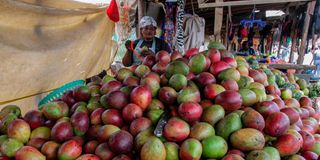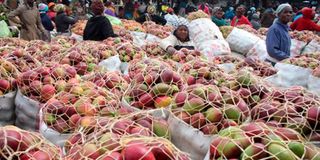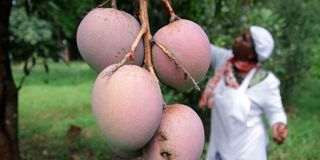
Traders select mangoes in Elburgon town, Nakuru County on January 19, 2024.
It is the mango season and that means we are seeing mangoes everywhere we go. Almost all the mangoes are juicy during mango season but some varieties are preferred over others.
Dr Lusike Wasilwa, Director Crop Systems at Kenya Agricultural and Livestock Research Organization (Kalro) explains why we are drawn to some varieties over others.

Traders display mangoes for sale at the Muthurwa market in Nairobi.
How many mango varieties are there in Kenya?
There are about 60 mango varieties and 24 accessions (local types) grown in Kenya. This means we have a total of 84 varieties. We classify the varieties as those that do well in low altitude areas, low to medium altitude areas and high altitude areas.
Varieties that do well in low altitude areas are Apple, Ngowe, Boribo, Dodo and Batawi while Tommy Atkins, Van Dyke, Alphonso, Kent, Haden, Sensation are better suited for low to medium altitude areas.
Is the nutritional value of mangoes the same across varieties?
The nutritional value is similar for all mangoes with all of them having high Vitamin C content. However, some mango varieties such as Apple, Ngowe and Boribo have high juice content while all the 24 local varieties such as Ngowe, Dodo and Apple have high fibre content.
Which varieties are preferred for export?
Of the 84 varieties, seven have been commercialised because of one factor, they bear red skinned fruit. They are Tommy Atkins, Van Dyke, Kent, Apple, Keitt, Sensation and Haden. Many people prefer red skinned mangoes because they look nice and are considered sweeter. The preference for red mangoes is not only locally but across the globe. The deep red colour attracts people to buy the fruit.
Why is there poor demand for the mangoes we are growing locally in Europe?
First, we have all the varieties available in our nurseries so there is no shortage of any particular variety. The problem is some Kenyan farmers who are planting hoping to export, do not plant the right variety in the right agro ecological zone.
For example, in high altitude areas like Kitale, the Apple mango will never turn red but if it was grown in Makueni, it would produce a good red fruit.

A farmer inspects her mango fruits in Nyeri town on January 31, 2024.
Majority of farmers plant Apple mangoes and grow it everywhere despite it not being suitable for all regions. It tastes good but the colour is not the one the global market prefers.
What other factors should farmers consider when planting mangoes for export?
Another reason why some mangoes do not develop red skins is if they are grafted on the wrong rootstocks. A rootstock is a stem with a well-developed root system to which a bud from another plant is grafted.
There are recommended rootstocks that Kalro guides farmers to use based on the zone they will be planted. Rootstocks recommended for coastal lowlands are Kitovu and Kimji, Peach and Sabre for highlands and Turpentine and 311 for saline soils.
Overall, which varieties give the best returns to the farmer?
The commercial varieties such as Apple, Ngowe, Tommy Atkins, Van Dyke, Kent, Keitt, Haden and Sensation.
Because these varieties grow the desired red-skinned fruit, farmers can then be able to sell not only locally but also export to Europe and the Middle East.
Some mango trees fail to flower and bear fruit after growing to maturity. Why is this so?
This is a natural phenomenon called alternate bearing. If the trees bear heavily one year, the production will be lower the following year.
Is there a way to cure this?
Yes, better fertility and growing varieties that are tolerant to alternate bearing could help. It is also important for farmers to manage the crop annually by constantly feeding the mango trees with both organic and inorganic fertilisers.
jmacharia@ke.nationmedia.com






